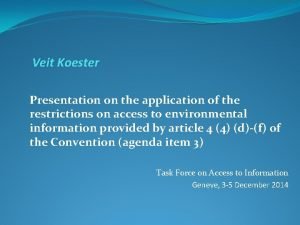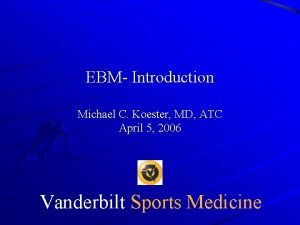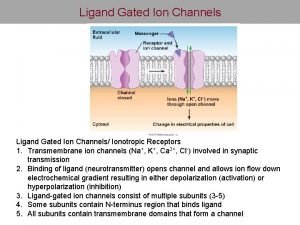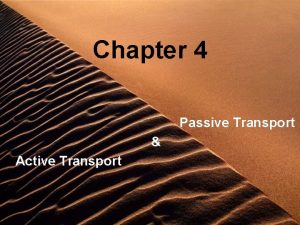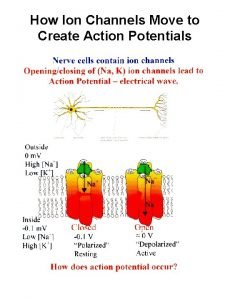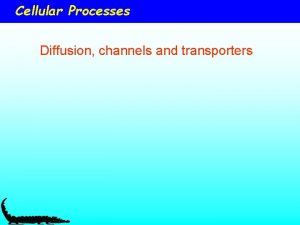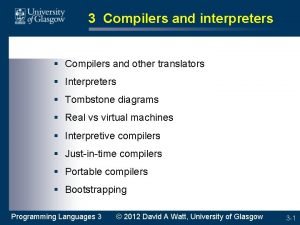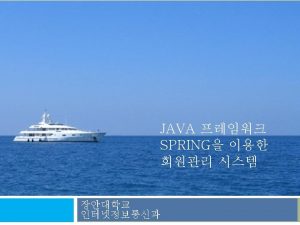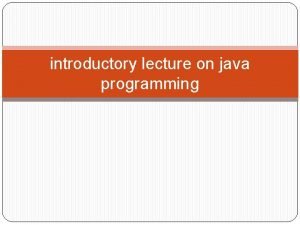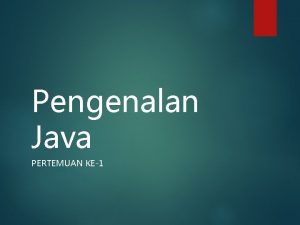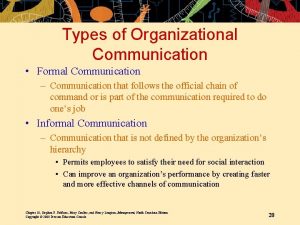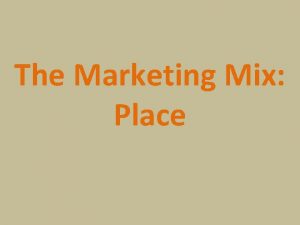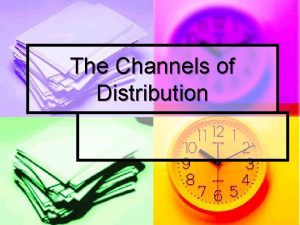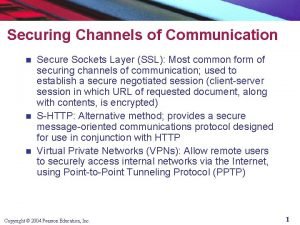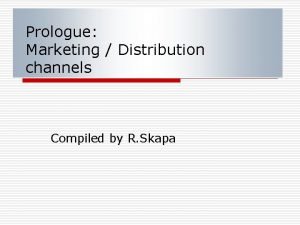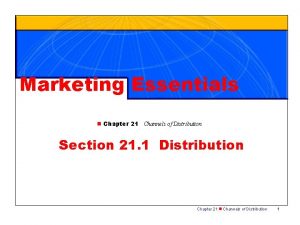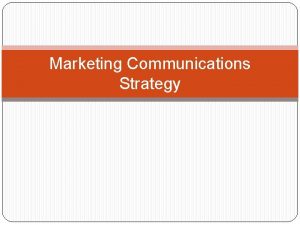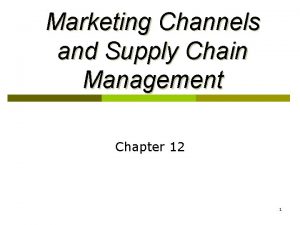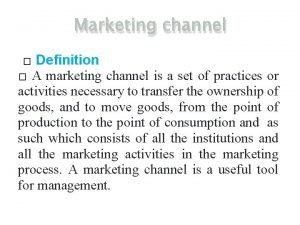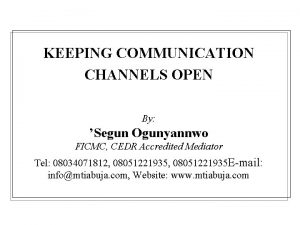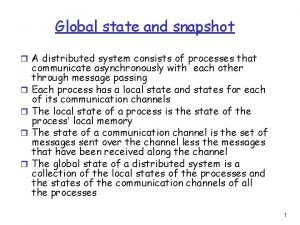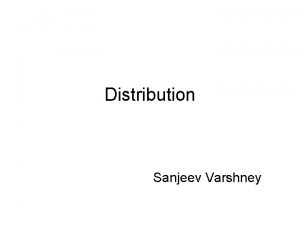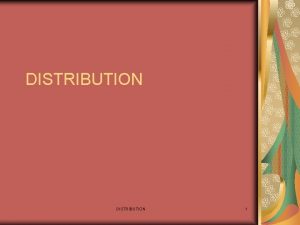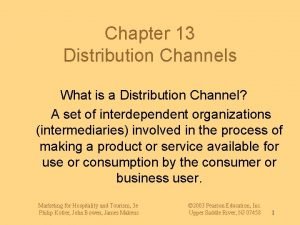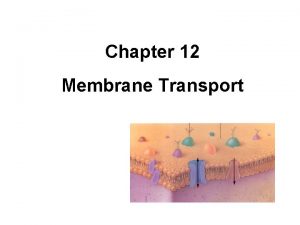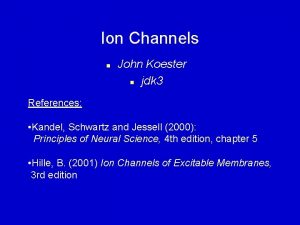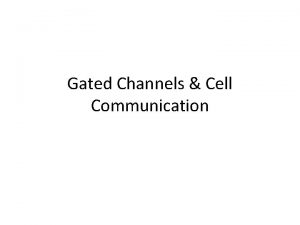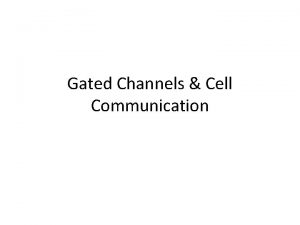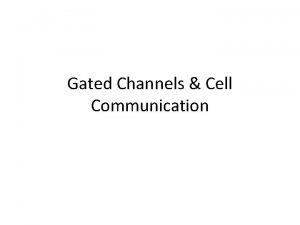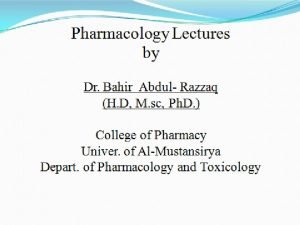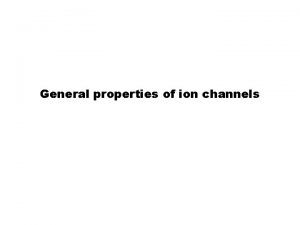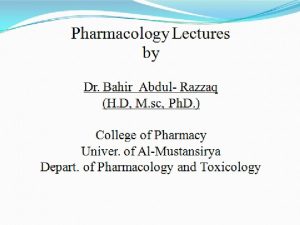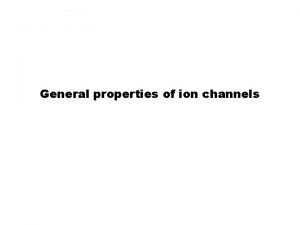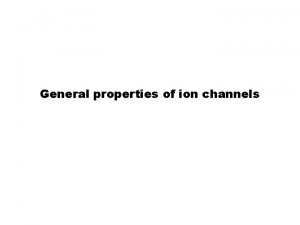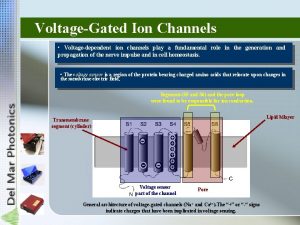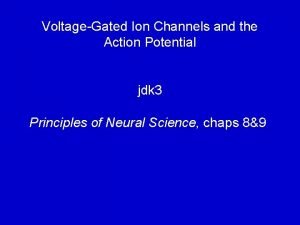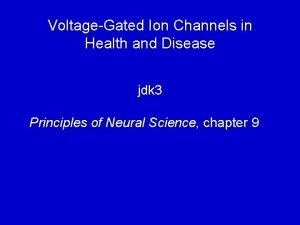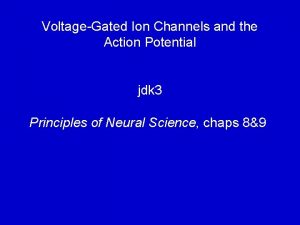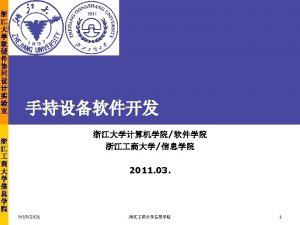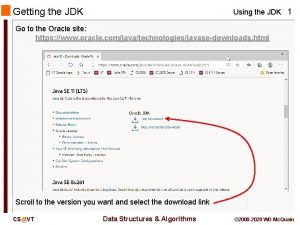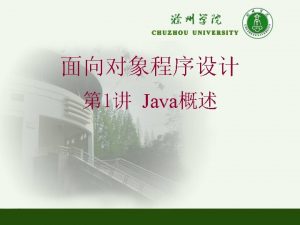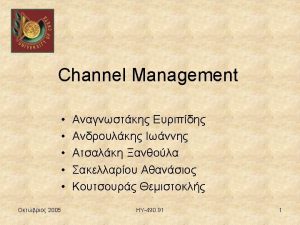Ion Channels n John Koester n jdk 3



















































- Slides: 51

Ion Channels n John Koester n jdk 3 References: • Kandel, Schwartz and Jessell (2000): Principles of Neural Science, 4 th edition, chapter 5 • Hille, B. (2001) Ion Channels of Excitable Membranes, 3 rd edition

Outline n n n Why ion channels? Channel structure Ion channels have three basic functional properties u Conduct u Select u Gate Evolutionary relationships between ion channels Various factors contribute to ion channel diversity

Ions Cannot Diffuse Across the Hydrophobic Barrier of the Lipid Bilayer

Ion Channels Provide a Polar Environment for Diffusion of Ions Across the Membrane

Specialized Functions of Ion Channels n Mediate the generation, conduction and transmission of electrical signals in the nervous system Control the release of neurotransmitters and hormones n Initiate muscle contraction n Transfer small molecules between cells (gap junctions) n Mediate fluid transport in secretory cells n Control motility of growing and migrating cells n n Provide selective permeability properties important for various intracellular organelles

Outline n n n Why ion channels? Channel structure Ion channels have three basic functional properties u Conduct u Select u Gate Evolutionary relationships between ion channels Various factors contribute to ion channel diversity

Channels are Made Up of Subunits

Outline n n n Why ion channels? Channel structure Ion channels have three basic functional properties u Conduct u Select u Gate Evolutionary relationships between ion channels Various factors contribute to ion channel diversity

Conduction • Ion Channels Conduct Up to 108 Ions/sec • Ion Channels Act As Catalysts • Speed up fluxes • Do not impart energy • Driving force is provided by electrochemical potential

Unlike Channels, Ion Pumps Do Not Provide a Continuous Pathway Through the Membrane Na+ K+

Outline n n n Why ion channels? Channel structure Ion channels have three basic functional properties u Conduct u Select u Gate Evolutionary relationships between ion channels Various factors contribute to ion channel diversity

Ion Channels are Selectively Permeable Cation Permeable Na+ K+ Ca++ Na+, Ca++, K+ Anion Permeable Cl -

Structure of K+ Channel Has Multiple Functional Adaptations Selectivity Filter

Outline n n n Why ion channels? Channel structure Ion channels have three basic functional properties u Conduct u Select u Gate Evolutionary relationships between ion channels Various factors contribute to ion channel diversity

Single Channel Openings are All-or-None in Amplitude, With Stochastically Distributed Open and Closed Times Closed Open 2 p. A 20 msec

There are Two Major Types of Gating Actions

Gating Can Involve Conformational Changes Along the Channel Walls

Gating Can Involve Plugging the Channel

Gating Can Result from Plugging by Cytoplasmic or Extracellular Gating Particles

There are Five Types of Gating Controls

1) Ligand Binding Extracellular Cytoplasmic

2) Phosphorylation

3) Voltage-gated Change Membrane Potential 4) Mechanical Force-Gated Stretch

Current 5) Temperature-gated Cold-Sensitive 20 25 30 Heat-Sensitive 35 40 45 Temperature (º C. ) 50

Modifiers of Channel Gating

Binding of Exogenous Ligands Can Block Gating (Curare) (BTx) (ACh)

Ion Permeation Can be Prevented by Pore Blockers PCP Glutamate-Activated Channel

Exogenous Modulators Can Modify the Action of Endogenous Regulators Current Time Open Closed

Outline n n Why ion channels? Ion channels have three basic functional properties u Conduct u Select u Gate Evolutionary relationships between ion channels Various factors contribute to ion channel diversity

Evolution Operates More Like a Tinkerer Than an Engineer

Ion Channel Gene Superfamilies I) Channels Activated by Neurotransmitter-Binding (pentameric channel structure): • Acetylcholine • GABA • Glycine • Serotonin II) Channels Activated by ATP or Purine Nucleotide. Binding (quatrameric or trimeric channel structure)

Ion Channel Gene Superfamilies III) Channels With Quatrameric Structure Related to Voltage-Gated, Cation-Permeant Channels: A) Voltage-gated: • K+ permeant • Na+ permeant • Ca++ permeant • Cation non-specific-permeant B) Cyclic Nucleotide-Gated (Cation non-specificpermeant) C) TRP Family (Cation Non-specific); Gated by: • osmolarity • p. H • mechanical force (hearing, etc. ) • ligand binding • temperature D) Channels Activated by Glutamate-Binding • quatrameric channel structure • cation non-specific permeability

Ion Channel Gene Superfamilies IV) “CLC” Family of Cl--Permeant Channels (dimeric structure): Gated by: • Voltage • Cell Swelling • p. H V) Gap Junction Channels (non-specific permeability; hexameric structure)

Outline n n n Why ion channels? Channel structure Ion channels have three basic functional properties u Conduct u Select u Gate Evolutionary relationships between ion channels Various factors contribute to ion channel diversity

Different Genes Encode Different Pore-Forming Subunits

Different Pore-Forming Subunits Combine in Various Combinations

The Same Pore-Forming Subunits Can Combine with Different Accessory Subunits

Alternative Splicing of Pre-m. RNA

Post-Transcriptional Editing of pre-m. RNA

Generator Potentials, �Synaptic Potentials and A Potentials All Can Be Described by the Equivalent Circuit Model of the Membrane PNS, Fig 2 -11

Equivalent Circuit Model of the Neuron The �Nerve (or Muscle) Cell can be Represented by a Collection of Batteries, Resistors and Capacitors

The Lipid Bilayer Acts Like a Capacitor ++ ++ -- -- Vm = Q/C ∆Vm = ∆Q/C ∆Q must change before ∆Vm can change

Change in Charge Separation Across Membrane Capacitance is Required to Change Membrane Potential + - + + - - - + + - + -+ +

The Bulk Solution Remains Electroneutral PNS, Fig 7 -1

Each K+ Channel Acts as a Conductor (Resistance) PNS, Fig 7 -5

Ion Channel Selectivity and Ionic Concentration Gradient Result in an Electromotive Force PNS, Fig 7 -3

An Ion Channel Acts Both as a Conductor and as a Battery EK = PNS, Fig 7 -6 RT z. F • ln [K+]o [K+]i

An Ionic Battery Contributes to VM in Proportion to the Membrane Conductance for that Ion

Experimental Set-up for Injecting Current into a Neuron PNS, Fig 7 -2

Because of Membrane Capacitance, Voltage Always Lags Current Flow t = Rin x Cin t PNS, Fig 8 -3

Length Constant l = √rm/ra PNS, Fig 8 -5
 Veit koester
Veit koester Follicule de koester définition
Follicule de koester définition Michael koester md
Michael koester md Transmembrane ligand gated ion channel
Transmembrane ligand gated ion channel The movement in and out of cells
The movement in and out of cells Translate
Translate Uniporter
Uniporter Jdk provides an interpretive compiler for java.
Jdk provides an interpretive compiler for java. Eclipse.ini jdk 설정
Eclipse.ini jdk 설정 Jdk jvm
Jdk jvm Jdk berisi sekumpulan
Jdk berisi sekumpulan Java project loom
Java project loom C6h12 fuerza intermolecular
C6h12 fuerza intermolecular Ion dipolo
Ion dipolo Que es fuerzas intramoleculares
Que es fuerzas intramoleculares Intermolecular forces
Intermolecular forces Horizontal communication
Horizontal communication Place channel
Place channel Selective distribution
Selective distribution Traction channels
Traction channels Specialty channels of distribution
Specialty channels of distribution The most common form of securing channels is through
The most common form of securing channels is through O & o channels
O & o channels Market logistics decisions for distribution channels
Market logistics decisions for distribution channels Part 6 you make the decision - distribution decisions
Part 6 you make the decision - distribution decisions Marketing environment framework
Marketing environment framework Types of distribution channels
Types of distribution channels Chapter 21 channels of distribution answer key
Chapter 21 channels of distribution answer key Channels for consumer products
Channels for consumer products Promotions mix
Promotions mix Multi channel distribution
Multi channel distribution Channel levels in marketing
Channel levels in marketing Marketing channels and supply chain management
Marketing channels and supply chain management Market channel definition
Market channel definition Keep communication channels open meaning
Keep communication channels open meaning The human inputs and outputs information through
The human inputs and outputs information through Global state in distributed system
Global state in distributed system Global market distribution
Global market distribution Global marketing channels and physical distribution
Global marketing channels and physical distribution Formal channels of communication
Formal channels of communication Various distribution channels
Various distribution channels Spatial convenience
Spatial convenience Delivery channels for entertainment
Delivery channels for entertainment Personal selling vs direct marketing
Personal selling vs direct marketing Channel design marketing
Channel design marketing Marketing channels: delivering customer value
Marketing channels: delivering customer value Direct marketing channel
Direct marketing channel Chapter 21 channels of distribution
Chapter 21 channels of distribution Marketing distribution channel
Marketing distribution channel Voltage gated vs ligand gated
Voltage gated vs ligand gated Indirect marketing channel
Indirect marketing channel Facilitating agencies in marketing channel
Facilitating agencies in marketing channel
